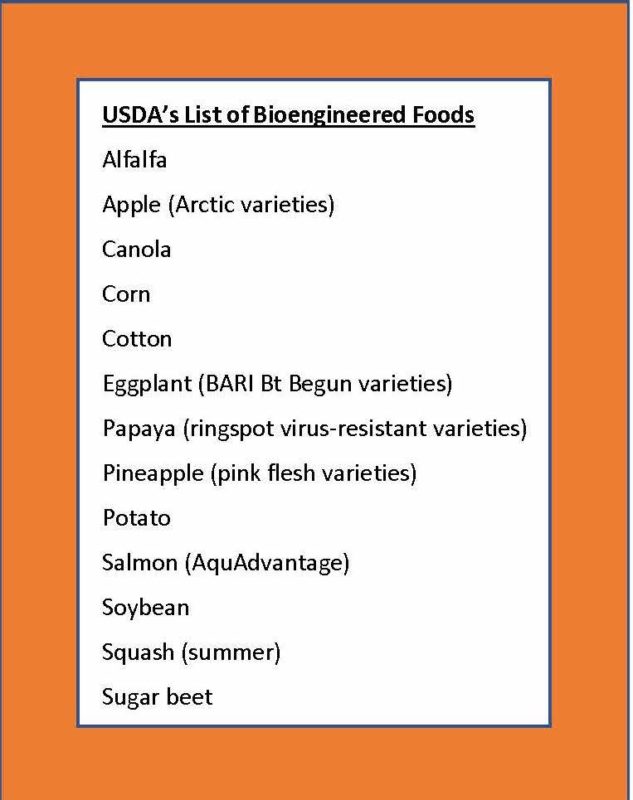When you go to the grocery store, have you noticed foods with messaging like “contains no GMOs” or “made with bioengineered ingredients” on the packaging? Most likely, you have seen a range of ways food manufacturers have chosen to share (or not share) this information. But starting Jan. 1, 2022, US Department of Agriculture regulations define how foods sold in the US that are bioengineered or contain bioengineered ingredients must disclose that information to consumers. In this post, I will break down the history and major components of this new requirement.
Background
In July 2016, President Obama signed the National Bioengineered Food Disclosure Law (NBFDL), requiring food manufacturers to disclose the presence of bioengineered foods and ingredients. A “bioengineered” plant or animal has had a new gene inserted into it to give it a useful trait. GMO papayas, for example, have been given a gene that makes them resistant to the ringspot virus. “Bioengineering” is a synonym for the more familiar terms “GMOs,” “genetically modified” and “genetically engineered.” A bioengineered food or ingredient must contain some of the newly introduced DNA. According to the National Academy of Sciences and the FDA, bioengineered foods are safe to eat and pose no risk to your health.
Required disclosure
The NBFDL and USDA’s regulations require all foods and ingredients that have modified DNA to make a disclosure using one of four methods of the food manufacturer’s choice. First, the food product can include the words “this is a bioengineered food” or “contains bioengineered ingredients” on the food product packaging near the ingredient list. Second, the food product can include the “bioengineered” symbol that USDA created in that same location. The third option is to put the disclosure online. The food manufacturer includes a QR code on the food package that takes you to an online webpage with the disclosure information (after you scan it with your smartphone camera). Finally, the food manufacturer can include a phone number on the package, which you can call or text to receive the information about bioengineered content.
These last two options are the reason the requirement is considered a disclosure rather than labeling. For all the disclosure options, the food manufacturer need not identify the specific engineered ingredient, so the consumer does not know which of the many ingredients in the product are bioengineered, only that the food contains at least one bioengineered ingredient.
Join Greg Jaffe on Feb. 10 for an AfS Live webinar and Q&A on the new disclosure rules
Disclosing ‘derived from’ ingredients
If one or more of a food’s ingredients come from a genetically modified plant, but the ingredients themselves contain no DNA from the GM plant, the label may carry a “derived from bioengineering” disclosure, but it is not required. This would apply to ingredients made from a bioengineered plant that are so highly processed that none of the plant’s modified DNA remains. Some example ingredients include corn or canola oil, sugar and high fructose corn syrup. In 2018, the Center for Science in the Public Interest—and even some food companies—urged the USDA to make “derived” disclosures mandatory, but the Trump Administration declined to do so.
Exemptions from disclosure
The law and regulations identify several exemptions from disclosure. These include restaurant food, foods produced by very small manufacturers, and products from animals that were fed bioengineered crops. Probably the most important exemption for consumers is the exemption for food products that contain meat, poultry and/or eggs. The new disclosure rules don’t cover products that list meat, poultry or eggs as their first ingredient (or their second ingredient after water, stock or broth) because those product labels are regulated by other USDA statutes. However, all food products with meat, poultry or eggs as the second ingredient (or third, where broth or water is the first ingredient) do require disclosure if they contain a bioengineered ingredient. This also means that if, in the future, we have bioengineered meat, poultry or eggs, and they are the main ingredient in a food, there will be no disclosure requirement.
Non-GMO disclosures
The law and regulations do not regulate claims asserting that the product is free of GMOs. Consequently, any food manufacturer can set its own standard for what constitutes a non-GMO food and claim their product meets that standard. The Non-GMO Project is a non-profit organization verifying products that meet its non-GMO standard. However, they also verify products that don’t have a GMO counterpart, such as unseasoned almonds or orange juice (there are no GM almonds or oranges produced anywhere in the world). Consumers who want to avoid bioengineered ingredients can purchase foods with the USDA “organic” symbol, as that government program does not allow the use of bioengineered seeds, animals or ingredients.
Bottom line
- GMO (bioengineered) foods currently available are safe. According to the National Academy of Sciences and the FDA, eating them poses no risk to your health.
- Many foods will now have to disclose that they contain “bioengineered” ingredients. The disclosure may be on the package or require going to a website or making a telephone call. The disclosure won’t tell you which ingredients are bioengineered.
- Disclosing “derived from” ingredients is voluntary. Oils, sugars, etc., made from bioengineered plants don’t have to be disclosed if no modified DNA remains in the ingredients, but a manufacturer may choose to do so.
- Restaurants, “very small” companies, most alcohol and foods with meat, poultry or eggs as a major ingredient aren’t required to disclose bioengineered ingredients. The disclosures are required on supplements.

